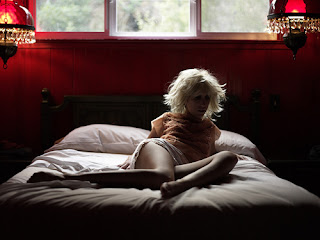The “Green Line Bus” scene of “The Royal Tenenbaums” is one of the most aesthetically pleasing scenes of any film I have ever seen. Aside from its technical aspects, there are dramatic levels of organization present throughout the scene that are present in many of Wes Anderson’s films. For example, as Richie Tenenbaum (played by Luke Wilson) enters the frame with his bags, there is a group of naval officers walking behind him in perfect formation. All of the bags and crates in the background of the scene are organized according to color, and this creates a beautiful backdrop that follows the rule of thirds. Anderson uses complimentary color palettes to show the viewer where the attention should be directed. In this scene, the green bus breaks the color palette, and in my opinion, adds to the heightened emotional state of the scene in its entirety.
The scene begins with a long shot of Richie Tenenbaum waiting for his escort to meet him at port after arriving home from his time at sea. A bus pulls up at the street over Richie’s shoulder in an over the shoulder extreme long shot, and Gwyneth Paltrow’s character, Margot Tenenbaum strolls off the bus. This is prevalent to the escalation of drama in the movie as Richie sent her a letter while at sea explaining his love for her. This shot sets up a shot-counter shot situation that Anderson utilizes to show the viewer the awkward tension between the two characters after being apart for an extended period of time. Margot is seen exiting the bus in a medium shot that allows the viewer to focus on her facial expression, which reveals that she is both nervous and anxious. The subsequent shot is a close up on Richie with his sunglasses on, and he has the tired, blank expression of longing. These two shots are repeated as Margot walks over to Richie, and the camera moves into a bust shot of Margot that creates more tension. It is also worth noting that after she exits the bus, all action takes place in slow motion, and this is obviously a choice made to heighten the intensity of the scene. As she approaches closer, Margot is framed in the same over the shoulder shot that was used when the bus first pulled up. At this point in the scene, Richie stands up to greet her and cracks a smile. The climax of the scene arrives when they are standing face to face, and she says, “Stand up straight and let me get a look at you.”
The cinematography within this scene tells the story of their relationship even better than the dialogue in several ways. First, as Alec Baldwin’s narration tells of Richie calling for his usual escort, we see the typical bustling of people around the street by the port, however, Richie is sitting and eagerly awaiting someone. As a first-time viewer, one would be fervently waiting to see who exits the bus. Since Richie has been gone for quite some time, it is crucial to the desired resolution of the plot that Margot come to pick him up so that the two can discuss the future of their relationship. Second, the background action’s uniformity makes the scene come to life as it feels that the only important interaction is that between Gwyneth Paltrow and Luke Wilson’s characters. The last reason the cinematography tells the story of this scene even better than the dialogue is due to the aforementioned tension that it builds between the two characters. Since Margot is married to Raleigh St. Clair, a successful psychologist, and she is Richie’s adopted sister, the pairing of these two seems unlikely. The eye level bust shots and medium shots used within this scene create a realistic flow between the two characters, focusing on their reactions to seeing each other. The long and extreme long shots are also vital to conveying the proper emotions within this scene as they represent the rapidly decreasing physical distance between these two characters who are destined to be together. Though the acting is undoubtedly exceptional, it is the framing of this scene that makes it truly beautiful.



















